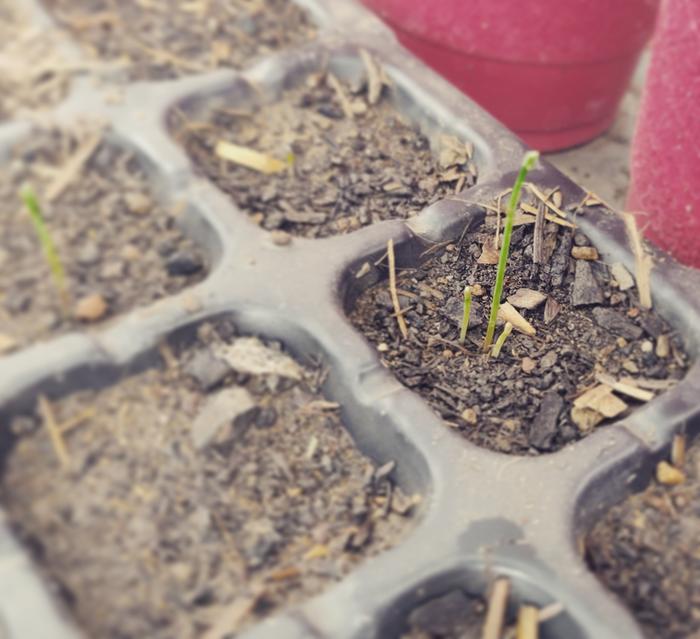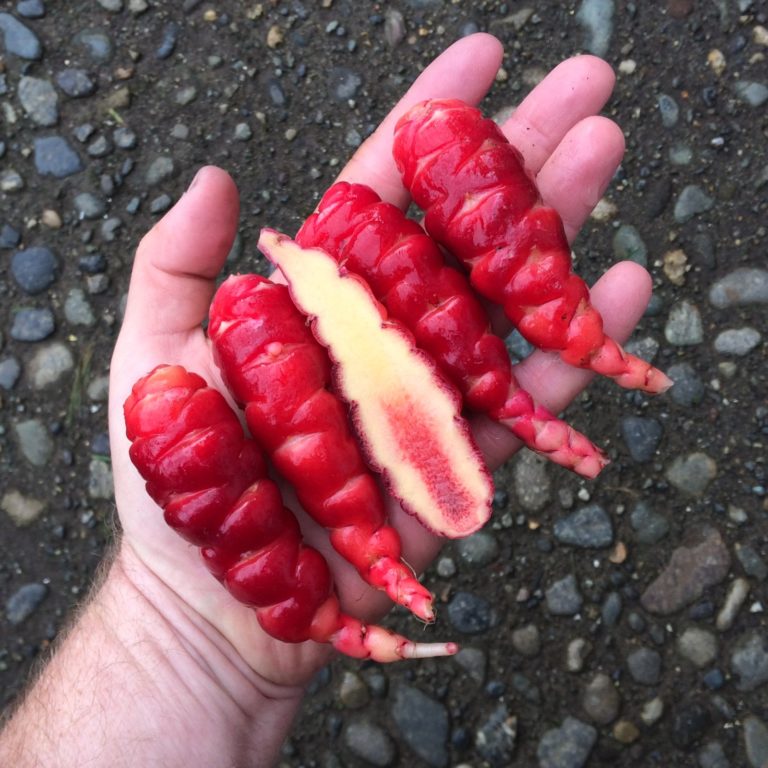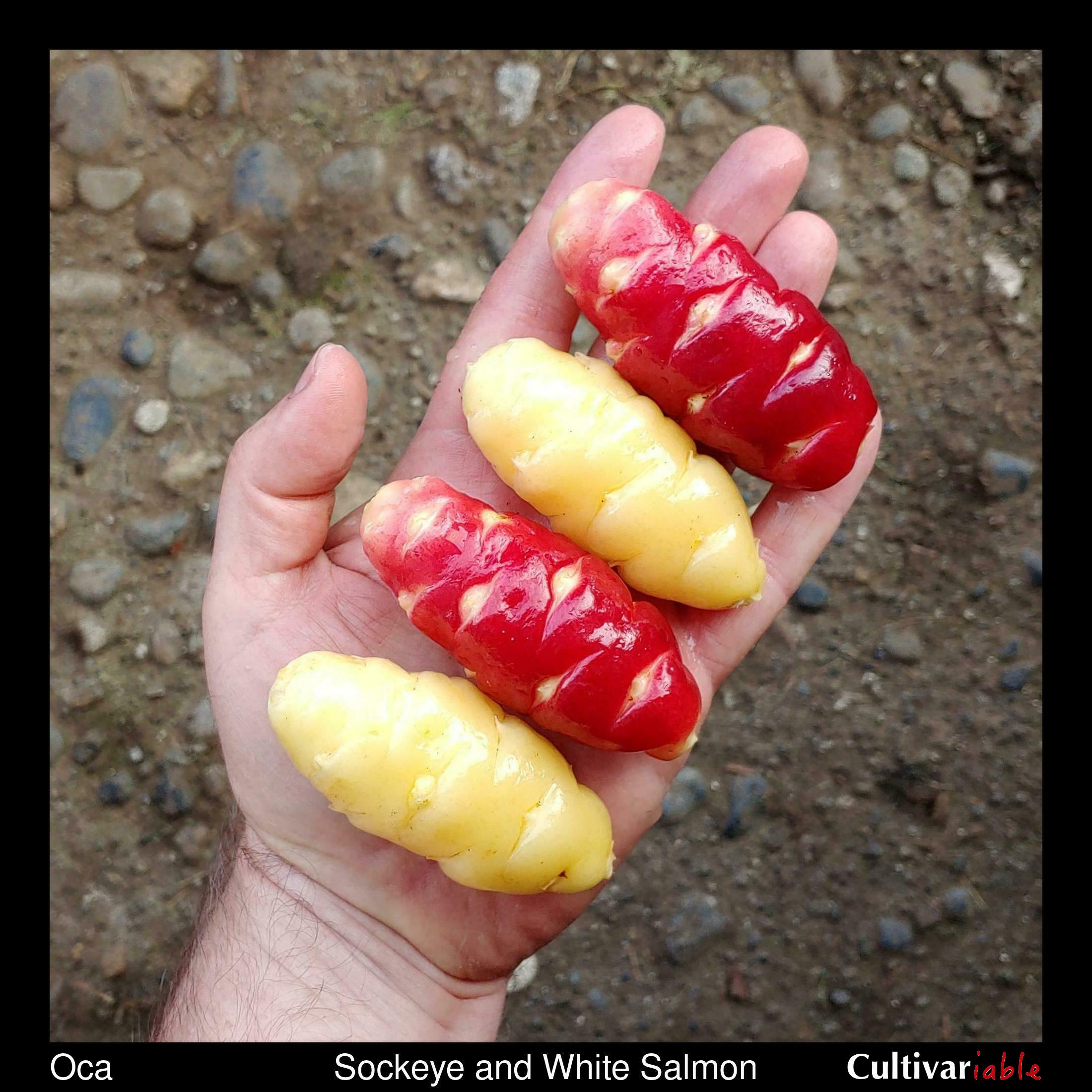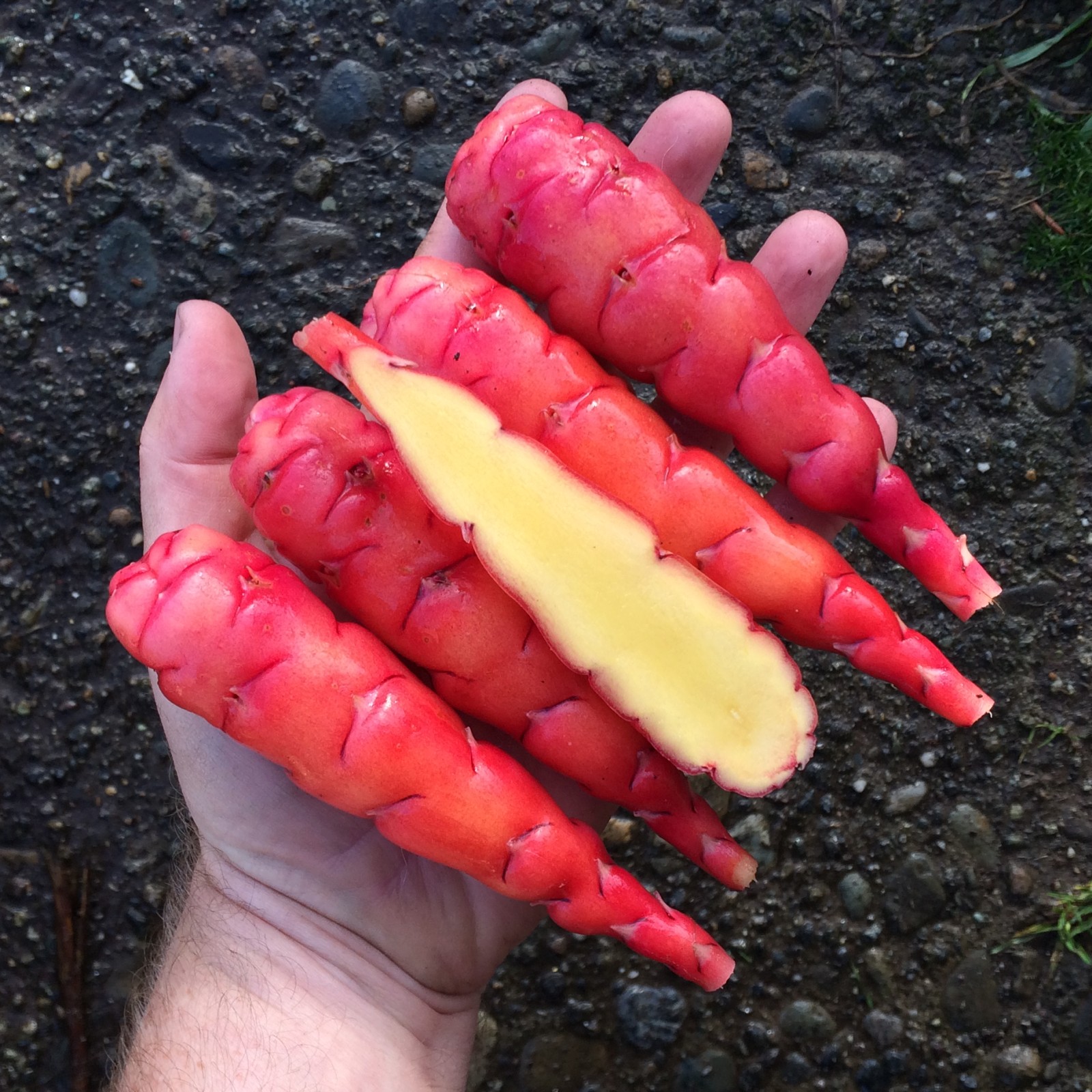
 9
9




This coming season I want to redouble my efforts to grow all of my own calories while I wait for the forest garden to take off, and I've been trying to nail down how many of each plant to grow. To that end I've built a simple spreadsheet that considers what percentage of your diet you want to come from different staple crops and then calculates how many plants you should grow to achieve that based on expected (usually minimum) yields.
This is about growing calories, not nutrition. It should not be assumed that whatever mix of crops you choose is in any way balanced or that they provide adequate nutrition. It's merely a tool for determining how many calories you can expect to grow with a given mix of plants. Nutrition is a different spreadsheet... {READ MORE}

Found this guy when I went to water my asparagus seedlings today. Of the 20 or so that have germinated so far, this is the only one that has sent up multiple shoots. I'm not sure yet if this is the result of some kind of damage or if it's some kind of genetic proclivity. I suspect that it might be the former, but I'm excited to see if out produces my other asparagus as it matures. If I'm that lucky, hopefully it's a female. That'll make it easier to get that trait in seedlings going forward, and will be respectable enough to divide those crowns and spread them around as is... {READ MORE}

I was planning to do a whole post on the Hugelpath once I finished setting it up and had some time to test it out. It's definitely theoretical at this point, but I'm hoping that theory will pan out as I do some testing. Basically, I'm trying to combine and maximize the benefits of a number of different designs will minimizing the negatives for my climate. Namely, it's inspired by hugelkultur, terra preta, ollas, worm towers, deep mulching, and a lot of Elaine Ingham's work (plus probably more techniques that I'm spacing on at the moment.) I think the only thing that's missing here would be to set them up on contour, but that might be excessive. I'll try to break down how the Hugelpath relates to each of these other technologies.
The relation to hugelkultur is probably obvious, even if "Hugelpath" is a bit of a misnomer since it is indeed not a mound. But since "hugel" has pretty much become synonymous with wood, it made sense. The problem with hugelkultur in my climate is that they don't maximize water harvesting; being a mound, in heavy rain events they will shed water in excess of what they can absorb and that water will run off of the property (or hopefully into other water catchment strategies.) By inverting the shape, water will shed INTO the hugel rather off of it. But with 8 or 9 months of nearly non-stop rain, even though I want to capture and hold onto that rain for use during the drought, I don't want it directly in the root zone of my plants where it can cause root rot. Instead, like an olla, this mass of spongey material will wick water into the adjacent beds as the plants use up water and dry out the soil relative to the hugelpath... {READ MORE}



I've observed cats and dogs self-medicating with grass for upset stomachs before, but I recently witnessed a behavior in my dog that I'd never witnessed in a dog before. In response to getting a thorn in her paw she chewed on some willow branches to extract the salicylic acid for use as a painkiller. Only after the willow kicked in did she lay down and pull the thorn out with her teeth... {READ MORE}

Went out this morning to check on the garden only to discover that something (likely birds, but possibly voles or other small rodents) have been digging up the peas I have that are just starting to germinate. I'm trying a combination of techniques with urine and sticks to deter the would-be thieves. I need zero budget natural solutions to my pest problem. I'm including a video of what I'm trying so far, but I'd love to hear if you have any other solutions that I might be able to employ... {READ MORE}
The Pull Sprout/Sprout Jacking methods are techniques for the rapid propagation of potatoes, especially for novel varieties grown from true potato seed (TPS), or in areas where seed tubers are difficult or expensive to acquire. I first learned about this method from the Cultivariable page on Andean potatoes. I haven't been able to find a lot of information on this method.
Has anyone used this method? Any tips or general process?... {READ MORE}


One of the major focuses of my study over the past few years has been in increasing the efficiency of dry farming/gardening on a home/homestead scale. This year I set out to design a bed that could, in addition to a dozen chickens, provide all of one's calories for an entire year without irrigating and with a minimal footprint. The point was to create a system that, once set up and planted, you could completely walk away from to go install food forest on your property knowing that that system would provide you with enough calories to eat in the meantime.
I don't have yield data yet, but so far this bed has performed better than expected. The growth is lush and green with no signs of moisture stress. The corn is tillering readily, which is a sign that it has the moisture and nutrition it needs to support the extra growth. I have not had to irrigate (and couldn't if I wanted to, on account of not having a functioning well-pump at the moment), and the lack of irrigation has meant that few new weeds have been able to germinate, though I have had to pull a few of the more pernicious perennial weeds, like Canada Thistle. All-in-all, I would estimate that I've spent less than 10 minutes a week weeding this bed, and expect to do less as my living mulch establishes... {READ MORE}

Olives are an unfamiliar beast to me. While these are Ukrainian varieties which are developed to handle a bit more cold, I was totally expecting them to defoliate once the cold weather hit. Not by a long shot. They still look as green and healthy as the day I put them in the ground.
This also serves as my cat's grave. She passed this year at 15 years old as an extra special fuck you from 2020. I piled large rocks around the trees to help hold in a little extra heat and then pulled wood chips about a foot deep to insulate the roots and reduce competition from the highly aggressive invasive weeds that surround it on all sides. I've also planted some cat nip in honor of my cat and some of the famous local variety of strawberry. Already planning to put in some chives and maybe some lovage and/or rhubarb. I'll probably figure out some berries that I want to put here; if not something that I already have, then maybe some strawberry tree in keeping with the (largely) Mediterranean theme. Also planning to throw in some peppers to help fill out the space this year, and this may end up being one of the spots where I put perennial kale and/or sea kale... {READ MORE}

I've received 3 varieties of oca in an effort to diversify my staple crops. I go live at 3pm PST (5pm CST/6pm EST) to unbox the order and show off these longer daylength varieties bred by Bill Whitson of Cultivariable.com. I couldn't find anyone showing their experience with Bill's varieties, or showing what people can expect to receive in their orders, so I wanted to document my experience for those who come after me. These were purchased at full price by a third party, so what I receive is what the average person could expect to receive.
Bill's website is a treasure trove of information on growing Andean crops like oca, mashua, and ulloco. In addition to showing what I actually received in the mail, I'll be going over the tasting notes and agronomic qualities for these three varieties and explaining why I chose these ones in particular. I'll also go over some of the vegetative propagation techniques that Bill suggests in his oca growing guide, which is how I plan to rapidly increase my stock of plants. I have no affiliation with Bill or Cultivarible, I'm simply excited for the work he's doing to preserve and expand the range of these wonderful crops. I'm happy that I get to grow them after years of researching and drooling over them... {READ MORE}



I was pretty bummed that we didn't have irrigation in time for me to plant fall and winter crops and that the rain started so late in the rainy season. I was really hoping to at least get some daikons, carrots, turnips, and greens in the ground but we just didn't have the soil moisture for it. Well, I ended up planting a couple hundred favas to overwinter and put down my first batch of compost from my deep litter system. Well, I had winnowed about 2.5 combined pounds of turnip and daikon seeds in my chicken pen and now they're coming up between the favas as a happy little accident. I think I'll broadcast a few more handfuls of daikons to really fill in the space. I'll harvest some of the roots, but most of them I'll chop and drop as the favas really start to push in spring. That'll give the daikons some time to break down before I plant the squash that will eventually be mulched with the remains of the favas... {READ MORE}
Growing the typical annual kitchen garden without irrigation has kinda become a pet project of mine over the last few years. That's since I've seen a few successful examples of it being done, and because I stumbled across an article stating that a third of America's poorest households are expected to be priced out of water in the next decade between the cost of replacing aging infrastructure and (mostly conventional agriculture... and now bottled water manufacturing) draining the aquifers dry.
I've shared some of the methods I use (which are only a fraction of the ones I've learned about so far) in this video. I hope it's okay to share it with you all. I'd love your questions and feedback (unless it's about how uncomfortable I am in front of the camera... I know... or the quality... best I can do filming and editing 100% on a phone... we don't have enough solar to run my computer yet)... {READ MORE}









 3
3





As someone who sees permaculture as a human-scale solution to a global problem (or problems), I’m a bit saddened by the obsession with industrial scale solutions like swales and terraces that, at least at the scale they’re typically used, are inaccessible to the poor and rural folks who are unable to afford heavy machinery. Certainly using swales is an effective strategy for securing water, and I certainly see the value in getting the job done quickly in order to fast track the repair process. But I’ve never been able to shake the feeling that A) bringing heavy equipment onto a piece of land does more damage, even if short term, than I’d like to see, and B) this obsession with heavy machinery leaves of dearth of options for the individual or small group practicing human-scale permaculture with hand tools.
I am one such person. I’m a long term steward of a rather large piece of property which the landowner would like to see producing most of their food. At this scale, typically excavators would be used to dig swales and ponds all over the property. As someone who is poor and only has access to hand tools, implementing an effective design becomes quite the ordeal once the usual tools of the trade are taken off the table.... {READ MORE}
 1
1




 1
1




 1
1




 4
4




 5
5




 3
3




 3
3





'What we do now echoes in eternity.' Marcus Aurelius
How Permies Works Dr. Redhawk's Epic Soil Series
 1
1




Jan White wrote:On the topic of gophers...
Our first year on the property, living in a tent, our fridge was a hole in ground. A nice hole - lined with lumber, about three feet deep. We haven't used it in a few years. Last night my husband said, "Oh by the way, take a look in the cold hole when you're out tomorrow."
"Why?"
"Just take a look."
Okay.

|
Wait for it ... wait .... wait .... NOW! Pafiffle! A perfect tiny ad!
Freaky Cheap Heat - 2 hour movie - HD streaming
https://permies.com/wiki/238453/Freaky-Cheap-Heat-hour-movie
|






